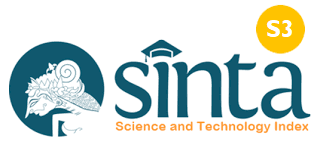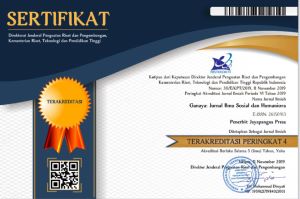The Traditional Gender Conceptions Among Sundanese in Rural Java and its Impact on the Community’s Post-Disaster Management
DOI:
https://doi.org/10.37329/ganaya.v8i1.3656Keywords:
Traditional Gender Conceptions, Gender Roles, Sundanese Community, DisasterAbstract
This study analyzes the traditional gender conceptions within the Sundanese community in Cikembang Village, West Java, explores the factors that shape these conceptions, and examines their impact on the community’s post-disaster management. Indonesia is prone to disasters, especially in West Java, where most of the Sundanese community resides. In 2021, a flash flood disaster occurred in one of the rural areas of West Java, namely in Cikembang Village. Gender as part of the socio-cultural structure influences how communities experience and respond to disasters, therefore, it is very important to study disaster events from a gender perspective. The research method used in this study is qualitative with a case study approach, and the data was collected through in-depth interviews and observations. This study shows that the Sundanese community has traditional gender conceptions, assigning distinct responsibilities to men and women. Men are seen as leaders and providers, while women are expected to nurture and fulfill reproductive roles. These gender conceptions are shaped by socio-cultural values and Islamic religious teachings. The rural context of Cikembang further solidifies the dominance of these traditional gender conceptions. These traditional gender conceptions greatly affect labor division in community post-disaster management. Men's dominance in leadership results in women's underrepresentation in decision-making, minimizing their contributions. It is essential to understand gender dynamics in disasters and recognize women's roles in resilience, as this can reveal how socio-cultural factors influence disaster-related social dynamics.
References
Akbar, A. A., Sartohadi, J., Djohan, T. S., & Ritohardoyo, S. (2017). Erosi Pantai, Ekosistem Hutan Bakau dan Adaptasi Masyarakat Terhadap Bencana Kerusakan Pantai Di negara Tropis (Coastal Erosion, Mangrove Ecosystems and Community Adaptation to Coastal Disasters in Tropical Countries). Jurnal Ilmu Lingkungan, 15(1), 1.
Alesina, A., Giuliano, P., & Nunn, N. (2013). On the Origins of Gender Roles: Women and the Plough. The Quarterly Journal of Economics, 128(2), 469-530.
Anggraeni, L. (2022). Equal Role Of Husband And Wife In Marriage Traditions Of The Baduy In Kanekes Village Leuwidamar Lebak Regency Banten. Al Hakam The Journal of Islamic Family Law and Gender Issues, 2(1), 35-47.
Apindiati, R. K. (2023). Peran Wanita Masyarakat Dayak Desa Rodaya Kalimantan Barat dalam Mewujudkan Ketahanan Pangan Lokal. Empiricism Journal, 4(2), 450-455.
Ashraf, M. A., & Azad, M. A. K. (2015). Gender Issues In Disaster: Understanding The Relationships Of Vulnerability, Preparedness And Capacity. Environment and ecology research, 3(5), 136-142.
Ayuningtyas, A. A., Rahman, E., Minza, W. M., & Nurdiyanto, N. (2020). Pembentukan Peran Gender Perempuan Etnis Minangkabau yang Merantau. Jurnal Psikologi, 16(2), 150-162.
Blackstone, A. (2003). Gender Roles and Society. Human Ecology: An Encyclopedia of Children, Families, Communities, and Environments, 335-338.
Chen, F., Bao, L., Lin, Z., Zimmer, Z., Socorro, G., & Borja, J. B. (2018). Double Burden For Women In Mid- And Later Life: Evidence From Time-Use Profiles In Cebu, The Philippines. Ageing and Society, 38(11), 2325-2355.
Chen, G., Zhang, J., Hu, Y., & Gao, Y. (2022). Gender Role Attitudes And Work-Family Conflict: A Multiple Mediating Model Including Moderated Mediation Analysis. Frontiers in Psychology, 13.
Çifçi, S., Saka, G., & Akın, A. (2022). Toplumsal Cinsiyet Algisi Ve Etkileyen Faktörler: Mardin Örneği. Turkish Journal of Public Health, 20(1), 1-13.
Cupples, J. (2007). Gender and Hurricane Mitch: Reconstructing Subjectivities After Disaster. Disasters, 31(2), 155-175.
Dodoo, F. N., & Tempenis, M. (2002). Gender, Power, and Reproduction: Rural‐Urban Differences in the Relationship Between Fertility Goals and Contraceptive Use in Kenya. Rural Sociology, 67(1), 46-70.
Eisend, M. (2019). Gender Roles. Journal of Advertising, 48(1), 72-80.
Enarson, E. (2012). Women Confronting Natural Disaster: From Vulnerability To Resilience. London: Lynne Reinner.
Enarson, E., Fothergill, A., & Peek, L. (2018). Gender And Disaster: Foundations And New Directions For Research And Practice. Handbook of disaster research, 205-223.
Fajria, I., & Handayani, B. L. (2022). Kapasitas Respons Tanggap Bencana Berbasis Gender, Budaya, Dan Kelas Sosial. JCIC: Jurnal CIC Lembaga Riset Dan Konsultan Sosial, 4(1), 1-12.
Fatema, S. R., Islam, M. S., East, L., & Usher, K. (2019). Women’s Health-Related Vulnerabilities In Natural Disasters: A Systematic Review Protocol. BMJ Open, 9(12).
Fatimah, S., Sarbaini, S., & Winarso, H. P. (2020). Hak dan Kewajiban Perempuan Dayak Warukin. Jurnal Pendidikan Kewarganegaraan, 9(1), 11-18.
Griffin, G. (2017). A Dictionary of Gender Studies. Oxford University Press.
Gunawan, N. A., Nurwati, N., & Sekarningrum, B. (2020). Analisis Peran Gender dalam Pengasuhan Anak pada Keluarga Etnis Jawa dan Sunda di Wilayah Perbatasan. Jurnal Pendidikan Ilmu-Ilmu Sosial, 12(1), 48-56.
Habibnejad, F., Elyasi, F., Nikbakht, R., & Shahhosseini, Z. (2023). The Factors Related to Gender Role Attitudes in Men and Women: A Narrative Review. Current Psychosomatic Research, 2(1), 3-18.
Hochschild, A., & Machung, A. (2012). The Second Shift: Working Families and the Revolution at Home. New York: Penguin Group.
Istenič, M. Č. (2007). Attitudes Towards Gender Roles and Gender Role Behaviour Among Urban, Rural, and Farm Populations in Slovenia. Journal of Comparative Family Studies, 38(3), 477-496.
Istianah, I. (2020). Perempuan Dalam Sistem Budaya Sunda (Peran dan Kedudukan Perempuan di Kampung Geger Hanjuang Desa Linggamulya Kecamatan Leuwisari Kabupaten Tasikmalaya). Al-Tsaqafa: Jurnal Ilmiah Peradaban Islam, 17(2), 195-204.
Jubreel, O. K., Ogunleye, K. Y., Ayoade, A. R., & Adeomi, D. T. (2024). Factors Affecting Changing Gender Roles Among Farm Families In Osun State, Nigeria. International Journal of Multidisciplinary Approach Research and Science, 2(2), 928-938.
Khoerunnisa, N., & Wandani, R. (2024). Relasi Gender Menurut Masyarakat Adat Karuhun Urang (Akur) Sunda Wiwitan di Susuru, Kabupaten Ciamis). Jurnal Ilmu Politik Dan Pemerintahan, 10(1), 65-71.
Korniawati, D., & Rahim, A. (2024). The Influence Of Patriarchal Culture On Social Life In Javanese Families In Wolio Sub-District. Cendikia: Media Jurnal Ilmiah Pendidikan, 14(6), 608-615.
Lahagu, A., Simanjuntak, F., Hasanah, U., & Pasaribu, J. (2024). Kesetaraan Gender dan Panggilan Perempuan dalam Pemberitaan Injil. Jurnal Teologi Gracia Deo, 6(2), 143-159.
Laudza, M. N., Antariksa, N. A., Sholihah, N. A., & Anisa, T. (2023). Persepsi Orang Sunda Terhadap Wanita Bekerja. Journal of Psychology Students, 2(1), 49-54.
Li, Y., Wang, X., & Mao, H. (2020). Influence Of Human Activity On Landslide Susceptibility Development In The Three Gorges Area. Natural Hazards, 104(3), 2115-2151.
Moser, C. O. N. (1993). Gender Roles, The Family And The Household. Gender Planning And Development: Theory, Practice And Training. London: Routledge.
Mulyanto, D. (2013). Bencana Alam: Suatu Tinjauan Antropologis dengan Kekhususan Kasus-kasus di Indonesia. Jurnal Ilmiah Etnografi Papua, 57-75.
Narawati, M. (2020). Representasi Budaya Patriarki Pada Komunitas Gereja Kristen Protestan Di Bali (GKPB). Pustaka: Jurnal Ilmu-Ilmu Budaya, 20(1), 38-45.
Neumayer, E., & Plümper, T. (2007). The Gendered Nature of Natural Disasters: The Impact of Catastrophic Events on the Gender Gap in Life Expectancy, 1981-2002. Annals of the Association of American Geographers, 97(3), 551-566.
Nurman, S. N. (2019). Keudukan Perempuan Minangkabau Dalam Perspektif Gender. JURNAL AL-AQIDAH, 11(1), 90-99.
Oakley, A. (2016). Sex, Gender and Society. London: Routledge.
Okoli, A. B., & Okwuosa, L. (2020). The Role Of Christianity In Gender Issues And Development In Nigeria. HTS Teologiese Studies/Theological Studies, 76(4).
Olatunde, O. J. (2022). Biblical Understanding of Male Headship and Female ‘Helpship’ in Marriage. Humanus Discourse, 2(3), 1-13.
Oliver, S. A., Alcántara, A. I., Burton, I., & Lavell, A. (2017). The Social Construction Of Disaster Risk: Seeking Root Causes. International Journal of Disaster Risk Reduction, 22, 469-474.
Pah, T. I. B. K. (2016). Relasi Gender Dalam Menghadapi Bencana di Kabupaten Malaka, Nusa Tenggara Timur (Gender Relations in Dealing with Disasters in Malacca Regency, East Nusa Tenggara). Jurnal Kajian IImu Administrasi Negara, 42(4), 1.
Panani, S. Y. P. (2021). Pandangan Buruh Gendong di Yogyakarta Terhadap Peran Ganda Perempuan. Jurnal Filsafat, 31(2), 290-312.
Pasaribu, R. H. (2023). Beban Ganda Perempuan Batak dalam Partisipasi Politik. Al Qalam: Jurnal Ilmiah Keagamaan Dan Kemasyarakatan, 17(1), 123-132.
Perry, R. W. (2018). Defining Disaster: An Evolving Concept. Handbook Of Disaster Research, 3-22.
Pohan, A. (2014). Gender Dalam Komunikasi Politik Aktivis Partai Islam (Analisis terhadap aktivis PBB, PPP dan PKS di Padang). Kafaah: Journal of Gender Studies, 2(1), 25-38.
Priess, H. A., & Hyde, J. S. (2011). Gender Roles. In B. B. Brown & M. J. Prinstein (Eds.). Encyclopedia of Adolescence, 1(2), 99-108.
Ramli, U., & Basri, L. (2021). Peran Gender Pada Masyarakat Bugis. Jurnal Noken: Ilmu-Ilmu Sosial, 7(1), 78-89.
Ridwan, I. R. (2010). Menyikapi Bencana Sebagai Fenomena Sosial Terintegrasi. Jurnal Geografi Gea, 10(1), 33-41.
Rohmana, J. A., & Ernawati, M. (2014). Perempuan Dan Kearifan Lokal: Performativitas Perempuan Dalam Ritual Adat Sunda. Musãwa Jurnal Studi Gender Dan Islam, 13(2), 151-165.
Sikandar, R., & Khan, A. (2019). Linking Gender Vulnerability And Disasters. Disaster Risk Reduction: Community Resilience and Responses, 215-230.
Simatupang, J. B. (2021). Perempuan dalam Budaya Adat Batak Toba. Jurnal Pendidikan Tambusai, 3(3), 10288-10296.
Sun, L., & Faas, A. J. (2018). Social Production Of Disasters And Disaster Social Constructs. Disaster Prevention and Management: An International Journal, 27(5), 623-635.
Sunarsih, S., & Benardi, A. I. (2022). Kajian Tingkat Kesadaran Masyarakat Kecamatan Bantarkawung Dalam Mengelola Lahan di Wilayah Rawan Bencana Tanah Longsor. Edu Geography, 10(1), 59-65.
Surya, A. (2020). Peran Perempuan dalam Ibadah: Dialektika Politik dan Teologi Tubuh. SOTIRIA: (Jurnal Theologia Dan Pendidikan Agama Kristen), 3(2), 84-94.
Susanti, S. (2014). Perspektif Gender Pada Masyarakat Sunda Di Desa Cikunir Kecamatan Singaparna Kabupaten Tasikmalaya Tahun 2013. Jurnal Kesehatan Bidkesmas Respati, 2(5), 20-29.
Tong, R. (2012). Encyclopedia of applied ethics. Cambridge: Academic Press.
Utami, C. W., Giyarsih, S. R., Marfai, M. A., & Fariz, T. R. (2021). Kerawanan Banjir Rob dan Peran Gender Dalam Adaptasi di Kecamatan Pekalongan Utara. Jurnal Planologi, 18(1), 94-113.
Uyun, Q. (2002). Peran Gender Dalam Budaya Jawa. Psikologika: Jurnal Pemikiran dan Penelitian Psikologi, 7(13), 32-42.
Yumarni, T., Amaratunga, D., & Haigh, R. (2014). Assessing Gender Vulnerability within Post-earthquake Reconstruction: Case Study from Indonesia. Procedia Economics and Finance, 18, 763-771.
Zhao, B., Yuan, L., Geng, X., Su, L., Qian, J., Wu, H., & Li, J. (2022). Deformation Characteristics Of A Large Landslide Reactivated By Human Activity In Wanyuan City, Sichuan Province, China. Landslides, 19(5), 1131-1141.
Downloads
Published
How to Cite
Issue
Section
License
Copyright (c) 2025 Fathimah Shidqi, Oekan S Abdoellah, Budiawati Supangkat (Author)

This work is licensed under a Creative Commons Attribution-ShareAlike 4.0 International License.
An author who publishes in the Ganaya : Jurnal Ilmu Sosial dan Humaniora agrees to the following terms:
- Author retains the copyright and grants the journal the right of first publication of the work simultaneously licensed under the Creative Commons Attribution-ShareAlike 4.0 License that allows others to share the work with an acknowledgement of the work's authorship and initial publication in this journal
- Author is able to enter into separate, additional contractual arrangements for the non-exclusive distribution of the journal's published version of the work (e.g., post it to an institutional repository or publish it in a book) with the acknowledgement of its initial publication in this journal.
- Author is permitted and encouraged to post his/her work online (e.g., in institutional repositories or on their website) prior to and during the submission process, as it can lead to productive exchanges, as well as earlier and greater citation of the published work (See The Effect of Open Access).
Read more about the Creative Commons Attribution-ShareAlike 4.0 Licence here: https://creativecommons.org/licenses/by-sa/4.0/.








